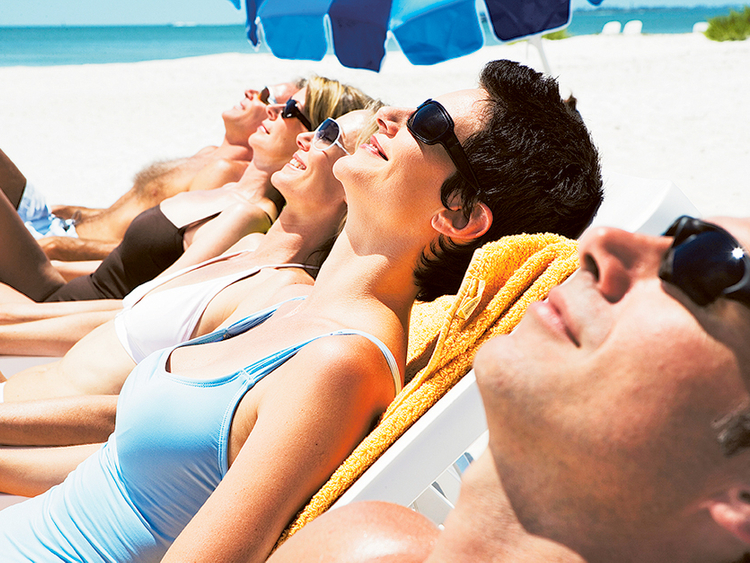Dubai: With the UAE’s temperatures rising, residents are advised to always make sure they wear sunscreen before stepping outside.
But just because you have a sunscreen on doesn’t mean you’re protected against skin cancer and other damaging effects of the sun. If you end up using the wrong product, you could be doing your skin more harm than good.
Dr Senthil Prabahar Samiraj, specialist in Dermatology and Venereology at Burjeel Hospital Abu Dhabi, said UAE consumers need to examine the fine print when shopping for a sunscreen and avoid buying products that contain toxic ingredients.
Samiraj said certain sunblock chemicals can actually cause an allergy reaction, skin cancer and disrupt the hormones.
Exposure to the sun has been linked to the development of skin cancers, which, according to the World Health Organisation, has been increasing over the past ten years, as the earth’s ozone layers are thinning out.
Each year, between two and three million non-melanoma skin cancers and 132,000 melanoma skin cancers are diagnosed globally.
“As ozone levels are depleted, the atmosphere loses more and more of its protective filter function and more solar UV radiation reaches the earth’s surface. It is estimated that a 10 per cent decrease in ozone levels will result in additional 300,000 non-melanoma and 4,500 melanoma skin cancer cases,” the World Health Organisation said.
Before heading out to the drugstore to grab your bottle of sunscreen, dermatologists advise that it’s best to write down these five ingredients to avoid: PABA (Para-aminobenzoic acid), Oxybenzone, Octinoxate, Retinyl Palmitate (Vitamin A Palmitate) and Homosalate.
Samiraj said that some of these ingredients, especially Oxybenzone, causes eczema-like allergy reaction when absorbed into the skin.
Octinoxate causes hormone disruption. “Its effect on estrogen can cause it to mimic or alter hormone levels.”
PABA is another chemical ingredient believed to increase the risk of skin cancer.
Retinyl Palmitate is an antioxidant but when exposed to the sun’s harmful UV rays, it damages DNA and becomes toxic to cells and may eventually lead to skin cancers.
Homosalate, another damaging ingredient, penetrates cells faster than other bodies can get rid of it, leading to disruption of hormones.
To ensure you are getting the maximum protection, look for the ingredients that have been approved by the Food and Drug Administration in the US.
“Chemical ingredients such as avobenzone and cinnamates absorb the harmful UV rays and convert the sun’s radiation into heat energy,” said Samiraj.
“Look for physical ingredients such as zinc oxide and titanium oxide to deflect and scatter the harmful rays before they penetrate into the skin. Zinc oxide is less whitening than titanium dioxide and provides better UVA protections along with UVB,” said Samiraj.
Samiraj also offers the following tips to choose the right sunscreen and avoid skin cancer:
1. Use water-resistant sunscreen when swimming
If you are a fan of swimming or are prone to excessive sweating, it is good to invest in a water-resistant product. Based on FDA guidelines, water resistant products must maintain the stated SPF level of protection after 40 minutes of immersion of the wearer in water, while a very-water-resistant product must maintain the protection after 80 minutes of water immersion.
Also, choose the formulations like cream, gel, lotion, oil free or for sensitive skin and preferably fragrance free.
2. Choose at least SPF 30 with good UVA protection, but it doesn’t mean SPF100 or those with higher SPF are the best
SPF in sunscreen denotes its ability to block out only ultraviolet B (UVB) rays and not the ultraviolet (UVA).
Prolonged exposure to UVB rays causes sunburns and can contribute towards the development of skin cancers. UVA rays cause skin tanning, skin damage, aging and also can cause skin cancers.
The SPF number is a factor and does not indicate directly the percentage of UVB protection. For instance, SPF 15 sunscreen blocks about 93 per cent of UVB rays, SPF 30 sunscreen blocks about 97 per cent of UVB rays and SPF 45 blocks about 98 per cent. It means increasing the SPF above 30-40 may not increase the protection.
Doctors recommend an SPF of 30 and above along with good UVA protection to ensure optimum skin health. Whatever may be the SPF, to ensure optimal sun care and protection; one should apply 30 minutes before sun exposure and must reapply every two hours.
3. How much sunscreen to use
The equivalent of one tablespoons of sunscreen is recommended for the face and three tablespoons or one ounce for exposed areas of the body. A nickel sized dollop is ample for just the face. Make sure you reapply sunscreen every 120 minutes.
4. Avoid too much sun exposure between 10am and 4pm
The sun’s rays are strongest between 10am and 4pm and it is advisable to stay out of the sun at this time.












